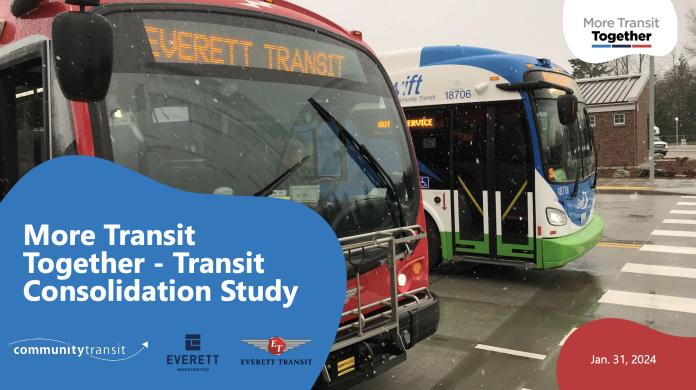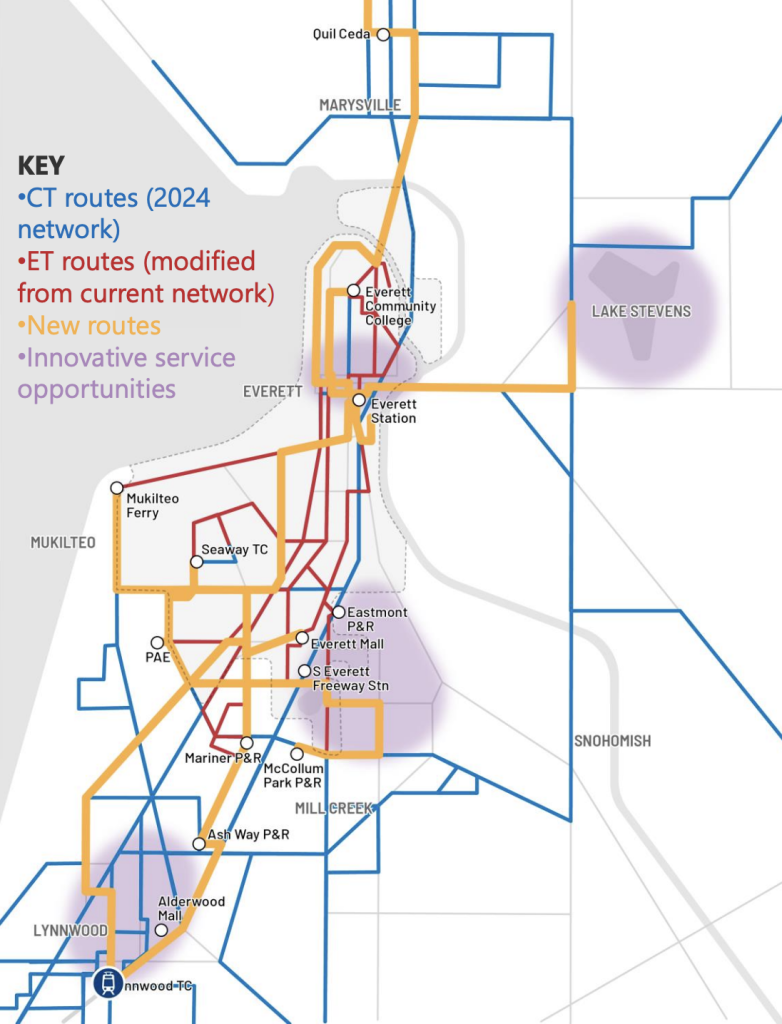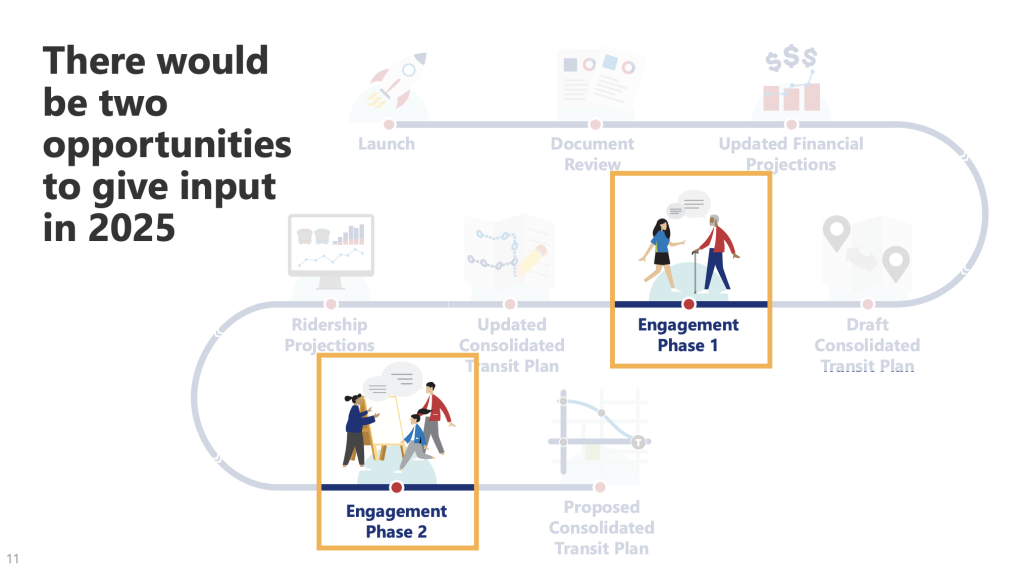
Everett Transit’s possible consolidation with Community Transit is advancing slower than anticipated, but emerging details suggest that transit riders in Everett could be better off if the city department folded into Snohomish County’s larger transit service provider.
Under today’s paradigm, Everett Transit has just 10 city bus routes with only three of those offering all-day service with 30-minute-or-better frequencies. The city also only runs three routes that operate after 9:00pm.
Community Transit thinks that consolidation could increase the number of routes to 15 in the city and approximately double current service levels. That could mean 14 bus routes would have all-day service with 30-minute-or-better frequencies and all routes would operate until 9:00pm or later. Consolidation could also mean running bus lines across city boundaries, streamlining service for many riders by reducing the need for transfers — which add travel time — and increasing access to other parts of Snohomish County.

Another benefit of cross-jurisdiction bus routes is that new alignments could bring riders directly to Link light rail stations when the Everett Link Extension opens. That would be particularly useful to transit riders in the central and southern parts of Everett where bus connections might otherwise require backtracking north to Everett Station or making an extra bus transfer to reach Link stations.
On top of this all, new microtransit services could be launched in Downtown Everett and the Eastmont/Silver Lake areas. That would likely be similar to Community Transit’s Zip Alderwood Shuttle, a flexible shared on-demand mobility service.
Not counted in the Everett bus route tallies are Community Transit services, which already cover parts of Everett with the Swift Blue and Green Lines as well as several stops on portions of Routes 105, 107, 201, 202, 227, 247, 270, 271, and 280. Those services are more or less expected to remain and are not funded by Everett residents beyond cost-sharing for the Swift lines.
Ronald Behee, Community Transit’s chief operating officer, spoke with the Everett City Council on Wednesday to provide some finer details on the consolidation service strategy. One key enhancement that Behee spoke to was coverage from new routes.
“There are some new routes that would be operated within the city that service some of the remaining gaps,” Behee said. “There’s not a lot of them, but there are some key areas, particularly when you look at some areas like South Everett that aren’t as completely covered as they might be.” Improved coverage could also come to North Everett.
Frequency and span of service improvements in Everett could also be quite significant, Behee noted in his remarks.
“The typical condition throughout the city is serviced every 30 minutes or better and in some of those busiest urban corridors service much more frequent than that when you think about 10 to 15 minutes service on corridors like Broadway, Evergreen Way,” Behee said of the consolidation service concepts. “And then that later service throughout the evening so that you’ve got access to service, you know, much more around the clock than is the case today.”
Community Transit operates several non-Swift routes into the 10:00pm and 11:00pm hours with more set to join the list later this year. Behee said that was quite possible on some Everett routes and that reaching at least the 9:00pm mark for all non-peak hours was a key priority.
New and modified routes along with span of service would certainly be major improvements, but frequency is a make or break for ridership, as Behee explained with 30-minute-or-better service.
“That’s where you really start to cross that threshold of getting to convenient transit that many more people would would find appealing,” Behee said. “And so it really convinces them to get out of their cars and take an alternate choice for travel.”
Consolidation has been many years in the making. Everett published its Rethink Transit policy guide in 2019 — an outgrowth of its 2018 long-range plan — which outlined three alternatives for the future of transit in the city: the status quo, growth through a small tax increase, or growth through consolidation with Community Transit. The city council opted to study the latter option in mid-2021 and later that year the City of Everett and Community Transit formalized a framework to evaluate and facilitate potential consolidation.
However, consolidation comes with several key challenges to be worked out, including:
- Winning voter approval for annexation of Everett into Community Transit’s service area and taxing district, which would increase the local transit sales tax from 0.6% to 1.2%;
- Getting buy-in and agreement from labor unions about personnel rights and benefits;
- Working out terms for a transfer of assets and facilities;
- Securing Everett representation on the Community Transit governing board; and
- Harmonizing policies and fares.

Tom Hingson, Everett Transit’s director, did share that the consolidation evaluation process had slowed significantly from what had been envisioned in the 2021 framework, which had anticipated delivery of a final integration plan around the middle of last year. “We appreciate the significance of this proposal and expect a long and robust period for input before any decision or even any request to make a decision,” Hingson said. “[A decision] is to be made no earlier than 2025.”
The new timeline would involve targeted stakeholder outreach during the first half of this year and then larger public engagement in 2025 with two key touchpoints between draft transit consolidation plans. Councilmember Paula Rhyne asked Behee why it seemed the project was mostly going on pause during the summer.
“There are some major initiatives on the plate for both agencies. I know the city has its own priorities in terms of what it wants to focus on this year,” Behee said. “Community Transit has the job of connecting to light rail in August and September of 2024, so we really want to focus entirely on that and make sure that we get that right.”
Consequently, public engagement reaching deep into 2025 portends that the soonest a consolidation measure would be put to the public is sometime in 2026 and likely in the fall when there is more turnout and a favorable electorate.
During the meeting, Everett councilmembers didn’t tip their hands on whether or not they’d support sending a consolidation measure to a public vote. But several councilmembers raised questions over the tax increase that would be required and noted that current Everett Transit workers seemed concerned about pay, benefits, and seniority — even though consolidation would require more, not fewer workers.
Stephen is a professional urban planner in Puget Sound with a passion for sustainable, livable, and diverse cities. He is especially interested in how policies, regulations, and programs can promote positive outcomes for communities. With stints in great cities like Bellingham and Cork, Stephen currently lives in Seattle. He primarily covers land use and transportation issues and has been with The Urbanist since 2014.

